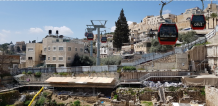Cable Car to the Old City, Jerusalem

In February 2019, the National Infrastructure Commission released Plan #86 to the public. The plan proposes constructing a cable car from the First Station in West Jerusalem, over the Valley of Hinnon, to Mount Zion and onward to the “City of David” in East Jerusalem. The main objective underlying the plan to construct the cable car to the Old City of Jerusalem is to transform the “City of David” into the dominant gateway into the Old City, inviting a steady stream of millions of tourists from around Israel and the world to enter through it.
The “City of David,” however, is located within Wadi Hilwa – Silwan. Hardly a small neighborhood (4,000-5,000 residents), the residents of Wadi Hilwa are in need of adequate planning to meet their needs in every aspect of their lives: residential spaces, educational buildings, playgrounds, and more. This neighborhood was never recognized by the State of Israel, even though many of its houses were built long before 1967. The building plans drawn up for this area designated land for conservation, archeology, as well as a wide variety of open spaces with considerable building restrictions. These plans come at the expense of essential public infrastructure in Wadi Hilwa, creating huge difficulties in the residents’ everyday lives.
The cable car is planned to pass directly above the roofs of the houses in Wadi Hilwa, and the foundations of the massive pilons supporting the cable car are planned to be built directly below the foundations of existing houses. The expropriation instructions are worded vaguely, such that the future of these homes remains unclear, making it difficult to know how to go about defending them. The train’s final station is planned over Kedem Center–a new visitors’ center that will be built in the “City of David.” A number of years ago, a plan was approved for the visitors’ center, but over the course of the opposition process, its walls were lowered so that it wouldn’t block the Old City’s walls. Now, with the generous assistance from the National Infrastructure Commission, the center is scheduled to recover the height it lost in previous iterations by adding another cable car station on the roof of the condensed building.
In an attempt to avoid further scrutiny, the cable car was called a “tourism-based transportation infrastructure.” The plan was promoted with the help of a particularly large public investment, even though formal or statutory procedures–not to mention social and public norms–did not take place in accordance with the law. In this case, the state is acting in violation of the law. If the plan is considered a project of transportation infrastructure, then the Ministry of Transportation should have been involved in its promotion. If the plan is considered tourism infrastructure, then the Minister of Tourism should have announced it. And yet, the Ministry of Transportation was apparently not involved, and there is no evidence of an announcement on the part of the Minister of Tourism in the records.
For these reasons and more, Bimkom, along with a number of residents of Wadi Hilwa, filed an objection to this plan (in Hebrew). View map submitted with objection.
The objection was rejected by the absolute majority, although the initial temporary expropriation period will most likely be shortened.
The plan will only be officially approved after the government votes on it.
In the meantime, the public debate in Israel and around the world continues.
